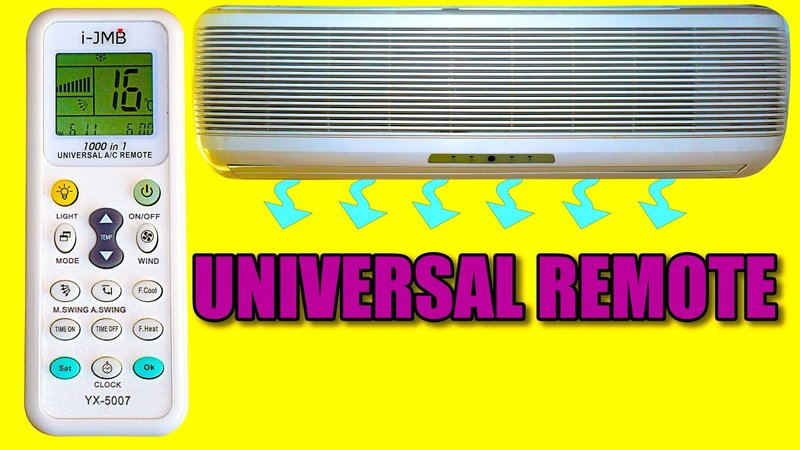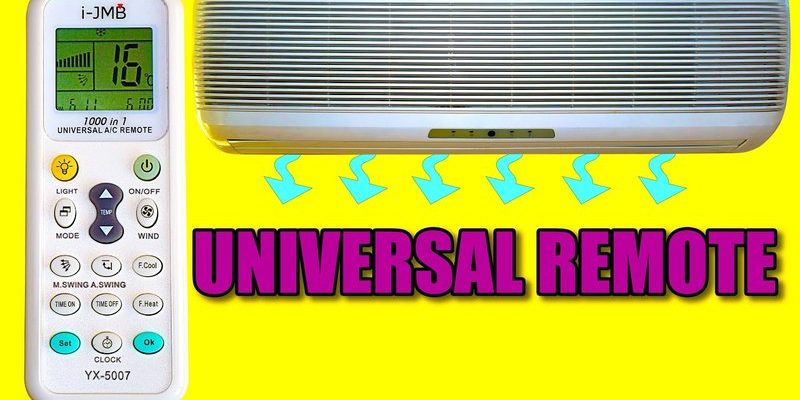
Think of your remote and AC unit like two new neighbors who need a quick introduction before they start exchanging casserole recipes. Even though both are from GE, sometimes the communication lines need a little nudge. Getting them to “talk” isn’t rocket science, but it does help to know the right steps, especially when codes, batteries, or syncing glitches decide to crash the party.
The GE remote we’re talking about here is those classic, gray-and-white controllers you probably recognize. Some are more modern, with digital displays and a bunch of buttons, while others keep it simple. No matter the type, most GE AC remotes follow a similar pairing routine. And yes—whether you’re dealing with codes, sync issues, or the inevitable battery “oops,” this guide’s got your back.
Understanding How Your GE AC Remote and Unit Communicate
Here’s something you might not realize: your GE AC remote and the air conditioner don’t just work together out of the box like long-lost twins. There’s an actual “handshake” that happens behind the scenes. Basically, the remote sends out an invisible burst of infrared light—kind of like a mini flashlight you can’t see—that carries out specific commands (like turning the AC on or changing the temperature).
The big catch? The AC unit needs to be tuned in to the exact “language” or code your remote is speaking. Without this initial communication, pressing those buttons is… well, pointless. It’s like trying to order sushi in a bakery—nobody’s going to understand you.
This is why pairing, syncing, and even resetting your remote is such a big deal. Each GE remote and unit have built-in codes so they can recognize each other and avoid picking up signals from your neighbor’s AC or your TV remote. It’s almost like a little secret handshake—if you don’t follow it, nothing works.
Before You Start: Prepping the Remote and AC Unit
Let me be honest—most pairing mishaps happen before you even start. Think about it: old batteries, blocked sensors, or not pointing the remote in the right direction are the classic culprits. So, before you jump into button-mashing territory, here’s what you should do:
- Check the batteries. If your remote’s batteries are even a little weak, those infrared signals could be too faint for the AC to notice. Pop in fresh ones. Don’t guess—replace them.
- Clear the path. Make sure nothing is blocking the little sensor on the front of the AC unit. I once spent ten minutes troubleshooting only to find my laundry basket was in the way. Oops.
- Know your model. Not all GE remotes and air conditioners pair the exact same way. Flip over your remote and unit for the model number. If you have the manual, keep it close. No shame in reading directions—promise.
If you’ve covered those bases, you’re already ahead of the game.
Pairing Your GE AC Remote: Step-By-Step Guide
Okay, moment of truth—let’s actually make this remote and AC unit become best friends. Most GE air conditioners follow a pretty simple pairing process, but if you’re stuck, these steps usually do the trick:
- Turn on your GE AC unit. Use the power button on the main console if the remote isn’t talking yet.
- Hold the remote close. Aim it directly at the sensor on your AC. Think of it like making eye contact—don’t just wave it around the room.
- Press the “Sync” or “Pair” button (if available). Some remotes have a dedicated sync button, while others use a combination (like holding “Power” and “Mode” together for a few seconds). If there’s no label, try holding the “Power” button for 5–10 seconds.
- Watch for a response. Your AC might beep, flash, or display a code on its screen. This is its way of saying, “Yup, got the message!”
If nothing happens, try the process again. Sometimes, you need a couple of attempts for the infrared signal to land cleanly. And if your remote requires entering a pairing code, check the manual or the small sticker inside the battery compartment. I know, squinting isn’t fun, but trust me—it’s worth checking.
Troubleshooting Common Pairing Problems
Let’s be real—things don’t always click on the first try. Maybe the AC just blinks at you silently, or the remote seems dead. Here are a few real-world fixes:
First off, reset both the remote and the AC. For the remote, this usually means removing the batteries, waiting a few seconds, and popping them back in—like hitting a refresh button. For the unit itself, unplug it for a minute, then restart. It’s amazing how often this basic trick fixes syncing glitches.
If your remote has a tiny “reset” hole (usually accessed with a paperclip), go for it. Hold it down for five seconds, and you might hear a beep or see a flash, letting you know it’s ready to try pairing again.
Another trick? Make sure your AC is in “remote-ready” mode. Some GE units have a “Remote” or “Pair” setting you need to activate. If you spot a “Lock” icon on the display, check if the remote control feature is accidentally disabled.
Sometimes, the simplest problems cause the biggest headaches. If you’re feeling stuck, it’s almost always something small—batteries, blocked sensors, or a missed step.
Pairing Codes: When and How to Use Them
Don’t you hate it when technology insists on codes? It’s like receiving a secret message, but you’ve lost the decoder ring. Some GE AC remotes (especially universal or replacement types) might prompt you for a pairing code before they’ll sync.
Where do you find this code? Most of the time, it’s hiding in the user manual, or printed inside the battery compartment. Some remotes scroll through code numbers while you hold down a specific button (usually “Set” or “Code”), and the AC unit responds when the right one pops up.
- If your AC beeps or displays a response as you test each code, that’s your match.
- Once you hear confirmation, lock in the code by pressing “Enter” or “OK.”
- If none of the codes work, double-check you have the correct model pairing—it’s easy to mix up codes between brands or units.
Honestly, this part can be tedious, but it’s a one-time hassle. Afterward, your remote should remember the code for future use (unless you take out the batteries for weeks or reset the remote).
Resetting Your GE AC Remote and AC Unit
At some point, everyone needs to hit the reset button—literally. Whether your remote seems stuck, or your AC is ignoring commands, resetting can clear out glitchy memory and start fresh. Here’s how the process usually works:
For the remote:
- Remove the batteries and wait at least 30 seconds.
- Press and hold any button for 10 seconds (to fully drain the little bit of electrical charge inside).
- Pop fresh batteries back in and try pairing again.
For the AC unit:
- Unplug the unit from the wall.
- Wait at least 60 seconds. Walk away—grab a snack if you have to.
- Plug it back in. The unit might “beep” as it reboots, signaling it’s ready again.
Sometimes, both the AC and remote just need that clean slate. Pairing after a reset often goes off without a hitch.
Comparing GE Brand Remotes and Universal Remotes
So, do you absolutely have to use the original GE remote? Here’s where things get interesting. If you’ve lost the original or it’s decided to retire early, you might be tempted by universal remotes.
GE brand remotes are obviously matched to your unit and usually pair super easily. They support all the modes—cool, fan, timer, you name it. But they’re not always easy to replace or cheap to buy.
Universal remotes come in handy when you can’t find the exact replacement. The tradeoff? Pairing can take more effort (entering codes, trial-and-error), and you might lose some specialty features. For example, you might be able to turn it on and change the temperature, but setting a sleep timer or switching modes could be hit or miss.
In my experience, sticking with the original remote is the smoothest road, but a universal option is better than sweating it out all summer.
Quick Fixes and Pro Tips For Smooth Pairing
Pairing your GE AC remote doesn’t have to be a stressful ordeal. Here are a couple of insider tips that have saved me (and more than a few friends) over the years:
- Keep the remote close to the unit when pairing. Seriously, sitting across the room won’t cut it. Those infrared signals have a short range, like a shy puppy.
- Double-check for firmware updates. Some newer “smart” GE units can update over Wi-Fi. If yours does, check for updates—this can squash weird pairing bugs you didn’t even know existed.
- Label your remotes. If you have more than one GE AC (lucky you!), stick a label on each one. Trust me, it saves a lot of confusion during hot afternoons.
- Don’t force the buttons. Pressing harder won’t make it work faster! If a button feels stuck, the remote might need a quick clean or a reset.
When To Call For Help (And What To Expect)
Sometimes you follow every step and still end up scratching your head. If your GE remote and unit just won’t sync, it’s totally okay to reach out to GE support or the store you bought it from. Keep your model number handy—they’ll ask for it. You might even be eligible for a free replacement if your remote is under warranty.
Here’s what they’ll probably have you do:
- Describe the problem, step by step (don’t worry about sounding silly—they’ve heard it all before).
- Walk through a reset or code entry process with you on the phone.
- If all else fails, arrange for a replacement or repair.
Sometimes, there’s a hardware problem that’s just out of your control, like a faulty sensor or remote board. It happens! But most of the time, a few simple troubleshooting steps will solve it.
Wrapping Up: Keeping Your GE AC Remote and Unit in Sync
You might be surprised how much smoother life gets once your GE AC remote and unit are paired and working as a team. No more frantic button-pushing, no more guessing games with the AC settings. Just chill, quite literally.
Pairing usually boils down to the small stuff: fresh batteries, a clear line of sight, knowing your model, and following the sync steps. If you hit a snag, resetting and using the right code does the trick for most people. And hey, don’t stress if it takes a couple of tries. Tech can be quirky, but once you know the secret handshake, you’re golden.
So, next time the summer heat rolls in, you’ll be sitting pretty—remote in hand, cold air on demand, and absolutely zero tech headaches. Not bad for a “simple” piece of plastic, right?
